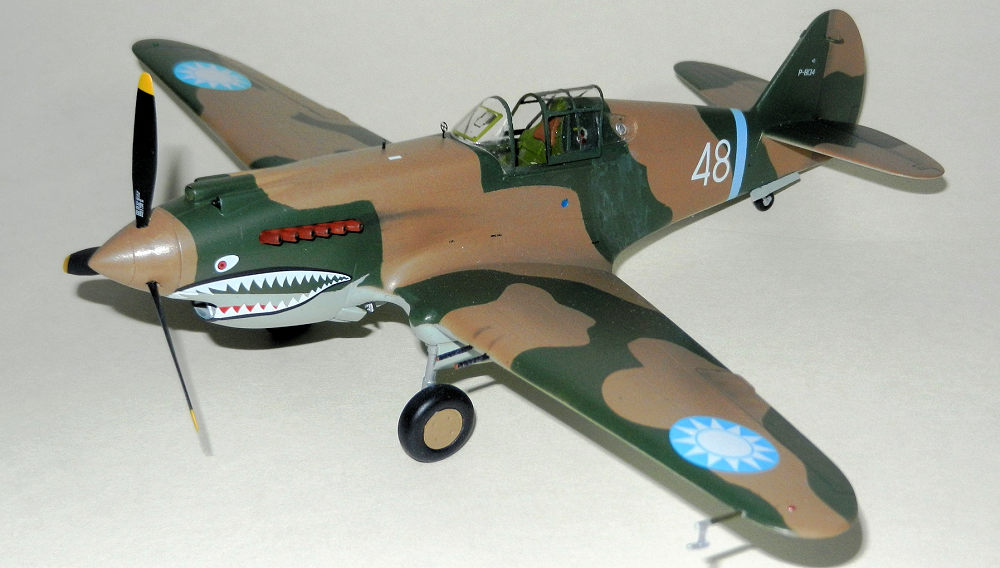
| KIT #: | HC 1451 |
| PRICE: | $22.00 |
| DECALS: | Two options |
| REVIEWER: | Pablo Calcaterra |
| NOTES: | Sky Models 48047 decals |

| HISTORY |
David Lee “Tex” Hill was born on July 13 1915 in Gwangj, Korea, the son of missionaries. He was raised in Texas thus his nickname. He attended San Antonio Academy where he graduated in 1928. He attended Texas A&M before moving to Austin College graduating in 1938. Watching cadets and Randolph Field flying around he got interested in flying. With a friend of his they paid a dollar to ride around the patterns in a Travel Air and his mind was now set.
He became a USN pilot in 1939 and flew Devastators and Vindicators from USS Saratoga and USS Ranger respectively. While on the later they flew patrols all the way to the Azores and would pinpoint to the British the presence of German submarines that where then attacked by they soon to be allies. On one occasion he spotted a tender with two submarines and informed a British destroyer who rushed to the scene. Later on and while flying over the same spot Hill saw oil slicks everywhere.
On March 1941 and arriving to Norfolk after one of their tours the pilots found Commander Irvine (AVG recruiter) looking for volunteers. Bert Christman, Ed Rector and Tex Hill were always together and they signed together. Their skipper flew to Washington to try to stop it but he was rebuked and when he returned he said “This is bigger than me!” Soon the three were released from the USN to join the AVG. Tex always wanted to return to Asia and when given the chance to join the AVG he did not have too many doubts as he wanted to join an adventure. Along with his buddies Ed Rector and Bert Christman Hill arrived to Burma aboard the Bloemfontein on September 15 1941. 2nd Squadron adopted the Panda Bears name, apparently pushed by Christman. The idea was to have Christman paint Panda Bear in a pose that represented the personality of her pilot. These Pandas were painted on the right side of the fuselage approximately lined up with the wing trailing edge. But when the action started not too many planes had received their cartoon. Hill’s “48” could have had a cowboy Panda Bear on boots, hat and with a bull skull.
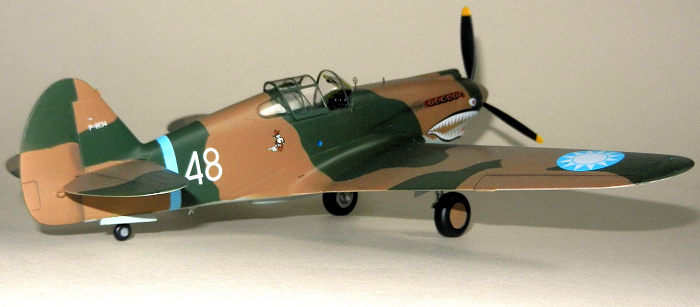 Hill had never seen a P-40
before as the Navy planes were powered by radial engines but found his new mount
“awesome”.
Hill had never seen a P-40
before as the Navy planes were powered by radial engines but found his new mount
“awesome”.
On December 9 1941 Keydaw was arisen by an alarm. Therefore the 4 planes in the alert flight took off at 3.30 am. After circling over their base for 90 minutes the planes came down to land. Lanterns were used to mark the runway but Hill overshoot it and destroyed “48” on the far end. The only picture I have found of his plane has the right wing covering the area where the Pandas were painted so there is no evidence of “48” having actually the cartoon.
When Air Vice Marshal Stephenson (RAF) arrived in the theater in January 1942 he immediately gave the order to “lean forward”. Thus a series of attacks on Thai airfields started. On January 3rd the Panda Bears led by Jack Newkirk took off to raid to Tak (Raheng for the Japanese). Christman aborted almost immediately with a problematic engine and thus only three P-40s went ahead: Newkirk, Howard and Hill. They flew beyond their target and then attacked with the rising sun on their backs. At that moment the Nates had just returned from a raid on Moulmein and there even was a crowd celebrating their success. Three Nates were on the ground, three more about to touch down. Focused on those enemies below Hill suddenly realized that their flight had been joined by another three planes: Nates! One latched on to Howard and was systematically damaging the Flying Tiger while Howard continued his run to attack a plane that had just landed Hill turned and shot down the plane attacking Howard. Then reversed his direction and shot at another Nate head one claiming it as shot down but in fact it had been Newkirk who also claimed this Nate for his 2nd kill of the mission. Hill’s plane had been hit 33 times by a Japanese plane he had not seen. A bullet hit his propeller when he shot at the Nate head on. The resulting out of balance propeller made the engine vibrate terribly to a point that Hill thought the engine would come out of his P-40. Howard came down for a 2nd attack on the airfield while the party celebrating was rushing everywhere. He destroyed another plane on the ground and then was hit by flak. With this propeller dead he started to look for a place to do a forced landing but suddenly the Allison came back to life. Howard’s plane had been hit 11 times. The three Panda Bears returned safely to their base where they claimed 4 destroyed on the ground and 3 shot down. Japanese records only show 2 damaged on the ground and 1 shot down.
On January 4th the Japanese launched another raid on Mingaladon. The Panda Bears and some Adam and Eves took off along with three newly arrived RAF Hurricanes. The Flying Tigers claimed 7 kills including one by Hill but only two are shown in Japanese records. Upon landing back at their base they found a Life magazine photographer and some of the Tigers including Hill posed with the rudder of a shot down Nate.
Twenty days later we find Hill attacking some Sally bombers (6 in this raid) that were escorted by Nates. While RAF Buffaloes and Hurricanes along with Hill, Rector and Neale went for the bombers the other 4 AVG pilots tangled with the Japanese escort. This meant that the Sallies were outnumbers for the first time and the Allied fighters made repeated passes until there were no more bombers in the air! One of Hill’s bombers exploded. He was attacked by a Nate but Tex turned the tables and shot it down thus becoming the second ace of the Panda Bears. The 14th Sentai had not lost a plane till then and now after two encounters with the AVG had lost almost 50% of their flight line. This forced them, as it had happened before with the 62nd Sentai, to attack under the cover of the night.
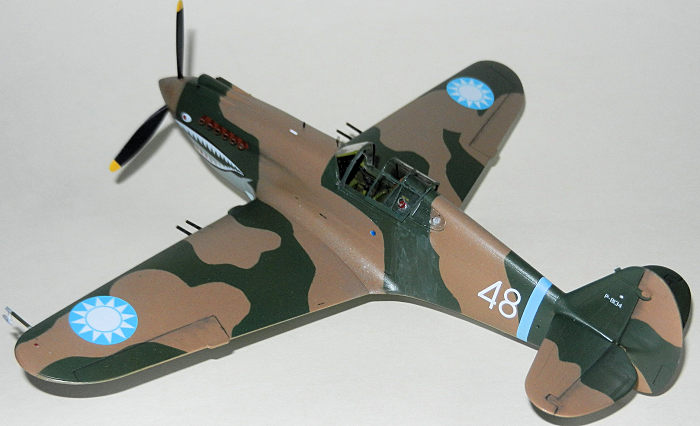 The 77th
Sentai send her Nates on a raid against Mingaladon on the 27th.
These 20 fighters were attacked by 10 Allied fighters led by Newkirk: five Panda
Bears including Hill, two Adam and Eves and two 17th
Squadron Hurricanes. Sandy Sandell also joined the action by himself. A damaged
Nate dove to the ground trying to destroy a Blenheim on the ground without
success. When Bond landed a RAF airman was making the V while with the other
hand was holding the helmet of the Japanese pilot…with the head still attached!
Against a claim for 14 kills (one for Hill) the Japanese had actually lost 4.
But since December 8th
the 77th
had lost 1/3rd
of the pilots and 50% of the planes.
The 77th
Sentai send her Nates on a raid against Mingaladon on the 27th.
These 20 fighters were attacked by 10 Allied fighters led by Newkirk: five Panda
Bears including Hill, two Adam and Eves and two 17th
Squadron Hurricanes. Sandy Sandell also joined the action by himself. A damaged
Nate dove to the ground trying to destroy a Blenheim on the ground without
success. When Bond landed a RAF airman was making the V while with the other
hand was holding the helmet of the Japanese pilot…with the head still attached!
Against a claim for 14 kills (one for Hill) the Japanese had actually lost 4.
But since December 8th
the 77th
had lost 1/3rd
of the pilots and 50% of the planes.
When Jack Newkirk died Hill was named Squadron Leader for the Panda Bears on April 2nd. Also the first P-40Es were received and with them the Tigers had a more powerful punch.
On April 10th and after a raid by Hayabusha’s led by Colonel Kato “Tex” Hill along with two AVG did a recco over Kyedaw airfield and then showed the CAF 12 pointed star to the Chinese troops in the air as a morale booster (these morale missions were hated by the AVG pilots)
The following day three Kityhawks flew a mission to Kyedaw. After strafing the Japanese one the ground twice thru heavy flak (Hill’s plane was hit during the second run) the planes returned safely to Lashio.
April 24th the Japanese were trying to cross the Salween River and they were now to the North of the retreating Allies troops. Had they succeeded they would have entered China and the war could have been over for the Chinese. Chennault decided to send waves of AVG planes to prevent this. During one of those missions six Kittyhawks armed with light bombs had Hill flying as tail-end Charlie to assess the results and then joined the attack. The AVG hit the Japanese hard and when a recco plane happened to enter the airspace in the area the six pilots shot it down. Finally after several more attacks by other AVG formations the Japanese retreated and then they were mopped up. Thus the critical danger for China ended.
To celebrate Emperor Hiroito’s 41st birthday the Japanese sent a large formation (24) of Sallies to attack the Allies, escorted by twenty Hayabuyas. Oley Olson led eight Tomahawks at 10,000 ft, covered by two more at few hundred feet above and these were in turn protected by a flight of Kittyhawks led by Hill. It was a huge air battle that pitted 44 Japanese against 14 AVG. Hill chased on fighter and after his 4th burst the Japanese started to dive till it hit the ground. His second kill happened during a head on attack against another Ki fighter while Bishop shot down a third plane that had latched to Hill’s tail. For another 14 kills claimed the Japanese only lost two failing to hit any of the AVG planes.
May 5th found a formation of six AVG delayed to escort a Douglas with evacuees. Yet when the Kittyhawks reached Boashan they found a formation of 16 Nates circling. The attack finished with 7 kills claimed to one Kittyhawk damaged by the explosion of his foe and another one lost when the pilot run out of fuel. In fact four Nates were lost…which amounted to 25% of the formation.
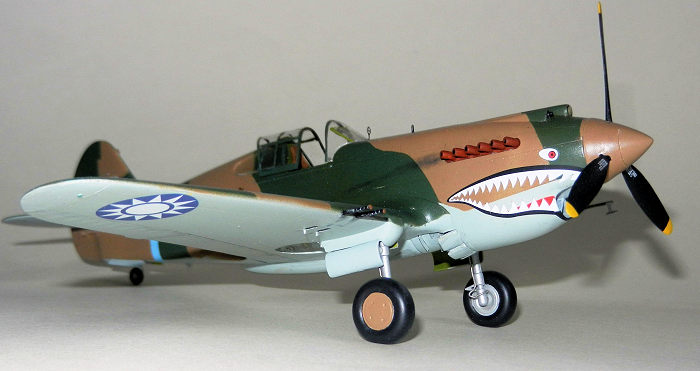 When the AVG disbanded on July 4th
1942 “Tex” Hill decided to join the 23rd
FG. The 23rd
FG was constituted by the 74th
Squadron (led by Schiel) and it was the “resurrection” of the Hell’s Angels
(including their 10 war weary Tomahawks, the 75th
led by Hill and the 76th
by Ed Rector.
When the AVG disbanded on July 4th
1942 “Tex” Hill decided to join the 23rd
FG. The 23rd
FG was constituted by the 74th
Squadron (led by Schiel) and it was the “resurrection” of the Hell’s Angels
(including their 10 war weary Tomahawks, the 75th
led by Hill and the 76th
by Ed Rector.
The following day the P-40s escorted five B-25s that attacked Canton. On the return flight one of the bombers was being attacked by Nates and the P-40s went to the rescue. In the ensuing combat Hill claimed another kill and therefore finishing as the 2nd most successful AVG pilot and, at the time, the 2nd top scoring US ace of WWII.
Another air battle took place when 12 B-25s escorted by seven P-40s raided Hong Kong on October 25, 1942. Eleven Japanese planes were confirmed destroyed while a B-25 was lost.
Early December 1942 Hill was sent back to the US to rest and support the war effort. He had to address the Joint Chiefs of Staff and felt pretty intimidated. Hill had to explain what the situation was on the China front. Later he was able to test multiple planes like P-51s, P-38, P-39 and P-47s along with P-40 N. His rest finished in October 1943 when he returned to China. Situation had changed by then and more resources were being pumped into this front. In fact they had received their first P-51s. He eventually became the leader of the 23rd FG.
On Thanksgiving Day 1943, he led a force of 12 B-25s, 10 P-38s, and 8 new P-51s from Saichwan, China, on the first strike against Formosa. The Japanese had a formidable force on the ground and they managed to get seven fighters airborne, but they were quickly shot down. Forty-two Japanese airplanes were destroyed, and 12 more were probably destroyed in the attack. The raiders returned home having lost no plane. It is believed that Hill was the first to down a Zero with a P-51
During his tenure with the 23rd FG Hill claimed five more (other sources say six) Japanese planes to be added to his 11.25 and eventually became Group Commander.
In 1944 Hill returned to the US and took command of the first jet fighter group flying Aircomets (“Not worth a damn”). He left the USAAF in 1945 but in 1946 he accepted the task to active the 136th Fighter Group of the Texas Air National Guard. He became the youngest Brigadier General in the history of the Air National Guard.
Tex Hill flew missions during the Korean War with the Texas National Guard and retired as Brigadier General.
He was awarded the Distinguished Service Cross, Distinguished Flying Cross with two Oak Leaf Clusters, Presidential Unit Citation with Oak Leaf Cluster, Chinese Order of the Cloud and Banner 4th, 5th and 6th grades, 2-Star Wing Decorations, Chinese Victory Medal, Legion of Merit, and British Distinguished Flying Cross.
| THE KIT |
For a comprehensive review check Scott’s review here
| CONSTRUCTION |
I decided to build a P-40 from each one of the 3 AVG squadrons. The 1st Squadron would be based on the oldest kit (Revell), 2nd Squadron based on the next kit released (Hobbycraft) and the 3rd Squadron using the Trumpeter kit. With more sources now available I fully understood the shortcomings of each kit (including my mistakes praising the HC kit in my MM Pearl Harbour P-40 review…)
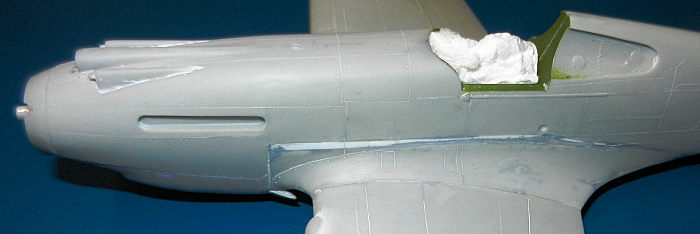 The first
part was to fix the height of the fuselage below the cockpit. There is a panel
line that runs from the tail to the engine cowls panel line. In the HC kit this
panel line stops at the back of the curved plates at the fuselage/wing joint. I
cut the fuselage at the wing root and glued it in the correct position.
Evidently this left a gap that I had to fill with plasticard and Tamiya putty.
The cowls were removed to be posed open later on. I drilled 2 shallow holes on
the side of the fuselage below the cockpit (formation lights) and with a smaller
drill bit the two points to hoist the fuselage close to the tail.
The first
part was to fix the height of the fuselage below the cockpit. There is a panel
line that runs from the tail to the engine cowls panel line. In the HC kit this
panel line stops at the back of the curved plates at the fuselage/wing joint. I
cut the fuselage at the wing root and glued it in the correct position.
Evidently this left a gap that I had to fill with plasticard and Tamiya putty.
The cowls were removed to be posed open later on. I drilled 2 shallow holes on
the side of the fuselage below the cockpit (formation lights) and with a smaller
drill bit the two points to hoist the fuselage close to the tail.
On to the
cockpit. I had to scratchbuild the lost fuselage frames lost inside the cockpit
due to this surgery mentioned above. Then I blanked the oval hole behind the
seat. I stole a photoeched central structure for the floor (photoetched set that
I had for the Trumpeter kit). The butt of the fuselage machine guns were
completed with short round stubs. The instrument panel was painted black,
drybrushed and Future was used for the faces of the instruments. Once everything
was painted I glued a little stub to the floor to
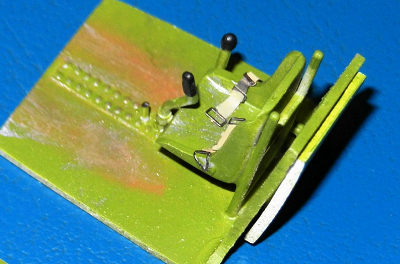 represent the light of the
reflector gunsight (thanks Scott for the schematic!) and painted it black. Most
of the AVG P-40s only had seat straps but not shoulder ones so I used some from
a set of photoetched lap belts.
represent the light of the
reflector gunsight (thanks Scott for the schematic!) and painted it black. Most
of the AVG P-40s only had seat straps but not shoulder ones so I used some from
a set of photoetched lap belts.
The fuselage halves were joined and the cockpit was inserted. The front of the rudder was modified with a drill to create the hole thru which the hinge of the rudder can be seen (this “hinge” was created using plastic rod).
Some extra work also took place on the wings. Some panel lines had to be scribed (not present in the kit). Also after looking at the Airfix kit at the local IMPS meeting I realized that the HC is missing the change in the angle (upwards) on the bottom of the wing tips. To achieve this I sanded the tip of the bottom halves in a shallow angle and then made a deeper incision along the panel line that runs at the end of the wing tip. This I bent upwards a bit and after some more sanding I achieved a look that I liked. Now the bottom of the wingtips moves up at a steeper angle than the rest of the wing.
The “nun-hat” is too skinny. Like I did with the Revell kit I decided to replace it using a copy of the Trumpeter kit. I made 2 molds (one for the HC kit and the other one for Revell’s) and filled them using 2 part epoxy. Breaking carefully the molds I ended up with 2 decent copies. I glued the wings to the fuselage and when dry surgery had to take place on the ventral part of the bottom half of the wings. I carefully removed this part along the panel lines and added two chunks of plasticard to act as support for the new “nun-hat”. After lots of dry fitting, cutting and sanding I glued the new ventral copy. Then putty fixed the gaps here and there and some more scribing completed the new underbelly. I also scratchbuilt the little “stops/deflectors” (?!) behind spent cartridges exits under the wings.
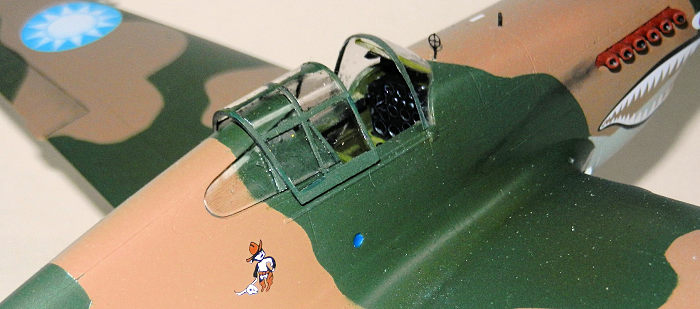 The kit was
purchased on eBay and upon receiving it I found that the windshield was missing
(got 30% off in return for this missing part). Having two versions from the
Revell kit (closed and open canopy) I decided to use the open version to copy it
using some old Squadron clear plastic heated with a candle. After two or three
failed tests I finally got something decent (but in the process I transferred so
much heat to the original windshield that now it is bent, fogged and useless).
The kit was
purchased on eBay and upon receiving it I found that the windshield was missing
(got 30% off in return for this missing part). Having two versions from the
Revell kit (closed and open canopy) I decided to use the open version to copy it
using some old Squadron clear plastic heated with a candle. After two or three
failed tests I finally got something decent (but in the process I transferred so
much heat to the original windshield that now it is bent, fogged and useless).
With tissue paper I created the fabric cover of the wheel wells. I scribed the panel lines on the horizontal tail surfaces and these were glued in place. The knuckles are not perfect in shape and with some putty and sanding I believe I have achieved a better look but not perfect.
I decided to open the holes in the exhausts. Using a pin to mark the center of each exhaust I then placed the drill bit carefully on that pin hole. Then with low speed I made a hole on each exhaust. I was surprised how easy it was and how realistic it looked.
Finally the cowls were glued back in place in an open position and with some scratchbuilt triangles in between (attention had been given to paint as good as possible the radiator on the front and the back).
| COLORS & MARKINGS |
I used scale plans from Tullis’ book to make a template of the camo pattern.
“48” had a very short life and did not even see combat being destroyed during the failed landing on December 9th. A coat of light grey was used to check for any imperfection. I painted the area before the tail in light blue (mix of white and blue) and then masked the Squadron ID band. There has been a lot of debate (just check the Web!) about the actual colour of these planes. They were, clearly, a close match (or as close as Curtiss wanted to stretch their efforts) to the RAF colours.
The undersides were painted with ModelMaster Acryl 4693 which is an excellent match of the original colour. Then this was masked and I painted the light brown (ModelMaster Acryl 4709) including the wheel hubs. Once dried, I barely sprayed a very light and much diluted coat of Sand (ModelMaster Acryl 4711) as the pilots described a faded out cammo especially on the wings, tail and fuselage spine (not so much on the fuselage halves)
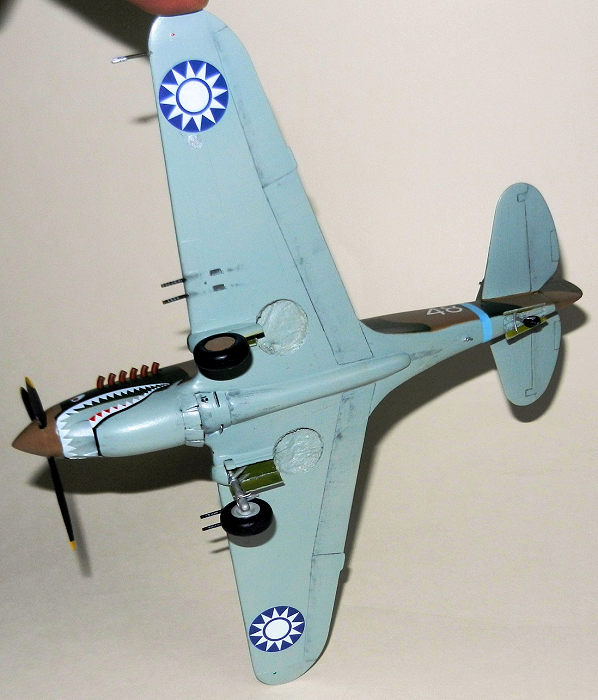 Then it was
time to mask the brown using the template mentioned above cut in Tamiya tape.
The green (ModelMaster Acryl 4726) was applied followed by a very diluted and
light coat of a darker shade of green (ModelMaster Acryl 4729) as the green
turned a darker/bluish tone when exposed to the sun. Again, as this plane had
had a short life this second overspray was very faint.
Then it was
time to mask the brown using the template mentioned above cut in Tamiya tape.
The green (ModelMaster Acryl 4726) was applied followed by a very diluted and
light coat of a darker shade of green (ModelMaster Acryl 4729) as the green
turned a darker/bluish tone when exposed to the sun. Again, as this plane had
had a short life this second overspray was very faint.
One issue that I found with the HC kit is that the propeller hub is made up of two parts that join in a place where the back plate on the actual place is located. I believe that HC idea was for the modeller to glue these together, use putty to erase the union and slide the propellers thru the openings using the little notches present. I did not realize this would have been the correct path till the plane was painted and the union of these two pieces was too evident. So now carefully I had to putty this union, sand it, and paint the propeller hug again. Not a perfect result but better than having 2 instead of one line!
Propeller is black with yellow tips. I used a thin black pencil to highlight the moveable surfaces and my typical sanded black pastels to give them a little bit of dirt. Same method was used for the machine guns and exhaust stains.
All formation lights were first given a drop of light grey, followed by silver and then a drop of Future with a touch of blue (fuselage) or clear red or blue for the wings. White was used for the ones on the tail.
The caps behind the pilot were painted in red and aluminum. Another tricky part was to simulate the dirty pattern created by the overflowing fuel below these caps. For this I used water with a drop of white and then put a tiny amount of this mixture on the fuselage blowing it downwards. It was repeated several times until it looked dirty enough with a help of a damped Q tip. Exhausts were painted using Rust colour and the openings black. The kit was given a coat of Future and was ready for the decals.
In terms of decals I found the Sky Models ones to be very good and accurate and most of the ones used on my kit came from it along with some from the HC kit itself. They reacted perfectly to Set and Sol solutions. I used some light blue roundels for the top of the wings (but not as light as on “7” – my Revell kit). As I did not have the Prestone one located on the nose I just cut a white rectangle minus the letters of course. For sake of adding some nice detail to the plane I added Hill’s Panda Bear though, as mentioned above, there is no photographic evidence of it being there.
| FINAL CONSTRUCTION |
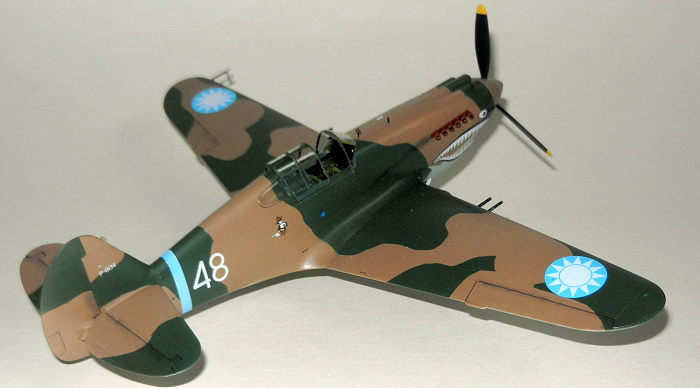 Lots of attention was given to the final details. These include photoetched
gunsight, the two little pipes under the fuselage, the oil vents by the nun hat,
two flaps opening on the first section of the nun hat (made with Evergreen), the
horn on the tail (for the rudder), drilling holes on the left side of the
fuselage Plexiglas panels (access to the fuel loading caps), pitot and a little
tab on the front of the vertical surface of the tail.
Lots of attention was given to the final details. These include photoetched
gunsight, the two little pipes under the fuselage, the oil vents by the nun hat,
two flaps opening on the first section of the nun hat (made with Evergreen), the
horn on the tail (for the rudder), drilling holes on the left side of the
fuselage Plexiglas panels (access to the fuel loading caps), pitot and a little
tab on the front of the vertical surface of the tail.
The on-the-field designed reflector gunsight was made up with clear plastic layers cut to shape following the pictures found in Larry Pistole’s book. A drop of brown was applied to the 4 wing machine guns to simulate dope.
Finally the windshield were glued after lots of testing and trimming (the height of the cockpit opening in the fuselage is not the same for Revell and Hobbycraft thus the profile of the bottom part of the windshield does not match at all!)
| CONCLUSIONS |
A satisfying project to bring the HC kit to what I believe it is a higher standard.
25 June 2018
Copyright ModelingMadness.com
If you would like your product reviewed fairly and fairly quickly, please contact the editor or see other details in the Note to Contributors.
Back to the Main Page Back to the Review Index Page Back to the Previews Index Page